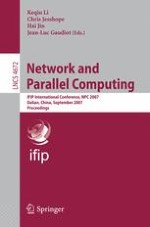Welcome to the proceedings of the 2007 IFIP International Conference on Network and Parallel Computing (NPC 2007) held in Dalian, China. NPC has been a premier conference that has brought together researchers and pr- titioners from academia, industry and governments around the world to advance the theories and technologies of network and parallel computing. The goal of NPC is to establish an international forum for researchers and practitioners to present their - cellent ideas and experiences in all system fields of network and parallel computing. The main focus of NPC 2007 was on the most critical areas of network and parallel computing: network applications, network technologies, network and parallel arc- tectures, and parallel and distributed software. In total, the conference received more than 600 papers from researchers and prac- tioners from over 20 countries and areas. Each paper was reviewed by at least three internationally renowned referees and selected based on its originality, significance, correctness, relevance, and clarity of presentation. Among the high-quality subm- sions, only 53 regular papers were accepted by the conference. All of the selected conference papers are included in the conference proceedings. After the conference, some high-quality papers will be recommended to be published in a special issue of several international journals.
